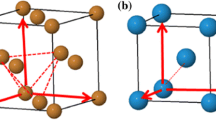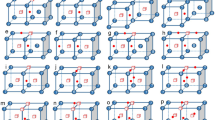Abstract
Density functional theory calculations and molecular dynamics with a recently developed potential for W–He were used to evaluate the thermal stability of helium-vacancy clusters (nHe.mv) as well as pure interstitial helium clusters in tungsten. The stability of such objects results from a competitive process between thermal emission of vacancies, self interstitial atoms (SIAs), and helium, depending on the helium-to-vacancy ratio in mixed clusters or helium number in pure interstitial helium clusters. We investigated in particular the ground state configurations as well as the activation barriers of self trapping and trap mutation, i.e., the emission of one SIA along with the creation of one vacancy from a vacancy-helium or pure helium object.

















Similar content being viewed by others
References
C.S. Becquart and C. Domain: The migration energy of He in W revisited by Ab initio calculations. Phys. Rev. Lett. 97, 196402 (2006).
A.S. Soltan, R. Vassen, and P. Jung: Migration and immobilization of He and H in gold and tungsten at low temperatures. J. Appl. Phys. 70, 793 (1991).
H. Trinkaus and B.N. Singh: Helium accumulation in metals during irradiation–where do we stand?. J. Nucl. Mater. 323, 229 (2003).
Y. Dai, G.R. Odette, and T. Yamamoto: The effects of helium in irradiated structural alloys. Compr. Nucl. Mater. 1, 141 (2012).
K. Nordlund, C. Bjorkas, T. Ahlgren, A. Lasa, and A.E. Sand: Multiscale modelling of plasma–wall interactions in fusion reactor conditions. J. Phys. D: Appl. Phys. 47, 224018 (2014).
H. Trinkaus: Energetics and formation kinetics of helium bubbles in metals. Radiat. Eff. 78, 189 (1983).
S.T. Picraux: Defect trapping of gas atoms in metals. Nucl. Instrum. Methods 182–183, 413 (1981).
E.V. Kornelsen: Entrapment of helium ions at (100) and (110) tungsten surfaces. Can. J. Phys. 48, 2812 (1970).
A. Van Veen, L.M. Caspers, E.V. Kornelsen, R. Pastenau, A. Van Gorkum, and A. Warnaar: Vacancy creation by helium trapping at substitutional krypton in tungsten. Phys. Status Solidi 40, 235 (1977).
W.D. Wilson: Theory of small clusters of helium in metals. Radiat. Eff. 78, 11 (1983).
K.O.E. Henriksson, K. Nordlund, A. Krasheninnikov, and J. Keinonen: Difference in formation of hydrogen and helium clusters in tungsten. Appl. Phys. Lett. 87, 163113 (2005).
C.S. Becquart and C. Domain: A density functional theory assessment of the clustering behaviour He and H in tungsten. J. Nucl. Mater. 386–388, 109 (2009).
J.H. Evans: An interbubble fracture mechanism of blister formation on helium-irradiated metals. J. Nucl. Mater. 68, 129 (1977).
J.H. Evans: The role of implanted gas and lateral stress in blister formation mechanisms. J. Nucl. Mater. 76–77, 228 (1978).
G.W. Greenwood, A.J.E. Foreman, and D.E. Rimmer: The role of vacancies and dislocations in the nucleation and growth of gas bubbles in irradiated fissile materials. J. Nucl. Mater. 4, 305 (1959).
W.R. Wampler, T. Schober, and B. Lengeler: Precipitation and trapping of hydrogen in copper. Philos. Mag. 34, 129 (1976).
J.H. Evans, A. Van Veen, and L.M. Caspers: Direct evidence for He bubble growth in Mo by the mechanism of loop punching. Scr. Metall. 15, 323 (1981).
R.J.K. Nicholson and J.M. Walls: FIM studies of the lattice damage in tungsten following low-energy helium ion bombardment. J. Nucl. Mater. 76–77, 251 (1978).
M.S. Abd El Keriem, D.P. van der Werf, and F. Pleiter: He-vacancy interaction in tungsten. Phys. Rev. B 47, 14771 (1993).
H. Iwakiri, K. Yasunaga, K. Morishita, and N. Yoshida: Microstructure evolution in tungsten during low-energy helium ion irradiation. J. Nucl. Mater. 283–287, 1134 (2000).
W.D. Wilson, C.L. Bisson, and M.I. Baskes: Self-trapping of helium in metals. Phys. Rev. B 24, 5616 (1981).
K.O.E. Henriksson, K. Nordlund, and J. Keinonen: Molecular dynamics simulations of He cluster formation in tungsten. Nucl. Instrum. Methods Phys. Res., B 244, 377 (2006).
F. Gao, Huiqiu Deng, H.L. Heinisch, and R.J. Kurtz: A new Fe-He interatomic potential based on ab initio calculations in α-Fe. J. Nucl. Mater. 418, 115 (2011).
R.E. Stoller, S.I. Golubov, P.J. Kamenski, T. Seletskaia, and Yu.N. Osetsky: Implementation of a new Fe–He three-body interatomic potential for molecular dynamics simulations. Philos. Mag. 90, 923 (2010).
A. Caro, J. Hetherly, A. Stukowski, M. Caro, E. Martinez, S. Srivilliputhur, L. Zepeda-Ruiz, and M. Nastasi: Properties of helium bubbles in Fe and FeCr alloys. J. Nucl. Mater. 418, 261 (2011).
L. Hu, K.D. Hammond, B.D. Wirth, and D. Maroudas: Interactions of mobile helium clusters with surfaces and grain boundaries of plasma-exposed tungsten. J. Appl. Phys. 115, 173512 (2014).
D.M. Stewart, Yu.N. Osetsky, and R.E. Stoller: Atomistic studies of formation and diffusion of helium clusters and bubbles in BCC iron. J. Nucl. Mater. 417, 1110 (2011).
D. Perez, T. Vogel, and B.P. Uberuaga: Diffusion and transformation kinetics of small helium clusters in bulk tungsten. arXiv:1406.6418v1[cond-mat.mtrl-sci] 25 Jun 2014.
N. Juslin and B.D. Wirth: Interatomic potentials for simulation of He bubble formation in W. J. Nucl. Mater. 432, 61 (2013).
G. Kresse and J. Hafner: Ab initio molecular dynamics for liquid metals. Phys. Rev. B 47, 558 (1993).
G. Kresse and D. Joubert: From ultrasoft pseudopotentials to the projector augmented-wave method. Phys. Rev. B 59, 1758 (1999).
J.P. Perdew and Y. Wang: Accurate and simple analytic representation of the electron-gas correlation energy. Phys. Rev. B 45, 13244 (1992).
H.J. Monkhorst and J.D. Pack: Special points for Brillouin-zone integrations. Phys. Rev. B 13, 5188 (1976).
S.J. Plimpton: Fast parallel algorithms for short-range molecular dynamics. J. Comput. Phys. 117, 1 (1995).
G.J. Ackland and R. Thetford: An improved N-body semi-empirical model for body-centred cubic transition metals. Philos. Mag. A 56, 15 (1995).
D.E. Beck: A new interatomic function for helium. Mol. Phys. 14, 311 (1968).
K. Morishita, R. Sugano, and B.D. Wirth: Thermal stability of helium–vacancy clusters in iron. Nucl. Instrum. Methods Phys. Res., B 202, 76 (2003).
C.C. Fu and F. Willaime: Ab initio study of helium in α-Fe: Dissolution, migration, and clustering with vacancies. Phys. Rev. B 72, 064117 (2005).
C.C. Fu and F. Willaime: Interaction between helium and self-defects in alpha-iron from first principles. J. Nucl. Mater. 367–370, 244 (2007).
G. Lucas and R. Schaublin: Stability of helium bubbles in alpha-iron: A molecular dynamics study. J. Nucl. Mater. 386–388, 360 (2009).
T. Jourdan and J-P. Crocombette: A variable-gap model for calculating free energies of helium bubbles in metals. J. Nucl. Mater. 418, 98 (2011).
A. De Backer, P.E. Lhuillier, C.S. Becquart, and M.F. Barthe: Modelling of the implantation and the annealing stages of 800 keV 3He implanted tungsten: Formation of nanovoids in the near surface region. J. Nucl. Mater. 429, 78 (2012).
A.V. Fedorov: Evolution of point defect clusters during ion irradiation and thermal annealing. Ph.D. Thesis, University of Delft, Delft, Netherlands, 2000, p. 25.
K. Morishita, R. Sugano, and B.D. Wirth: MD and KMC modeling of the growth and shrinkage mechanisms of helium–vacancy clusters in Fe. J. Nucl. Mater. 323, 243 (2003).
E.V. Kornelsen and A.A. Van Gorkum: A study of bubble nucleation in tungsten using thermal desorption spectrometry: Clusters of 2 to 100 helium atoms. J. Nucl. Mater. 92, 79 (1980).
D. Nguyen-Manh and S.L. Dudarev: Trapping of He clusters by inert-gas impurities in tungsten: First-principles predictions and experimental validation. Nucl. Instrum. Methods Phys. Res., B, submitted (http://arxiv.org/ftp/arxiv/papers/1408/1408.0630.pdf).
C.S. Becquart and C. Domain: Ab initio calculations about intrinsic point defects and He in W. Nucl. Instrum. Methods B 255, 23 (2007).
G. Henkelman and H. Jonsson: Improved tangent estimate in the nudged elastic band method for finding minimum energy paths and saddle points. J. Chem. Phys. 113, 9978 (2000).
G. Henkelman, B.P. Uberuaga, and H. Jonsson: Climbing image nudged elastic band method for finding saddle points and minimum energy paths. J. Chem. Phys. 113, 9901 (2000).
A. Nakano: A space-time-ensemble parallel nudged elastic band algorithm for molecular kinetics simulation. Comput. Phys. Commun. 178, 280 (2008).
E. Bitzek, P. Koskinen, F. Gahler, M. Moseler, and P. Gumbsch: Structural relaxation made simple. Phys. Rev. Lett. 97, 170201 (2006).
J. Boisse, C. Domain, and C.S. Becquart: Modelling self trapping and trap mutation in tungsten using DFT and molecular dynamics with an empirical potential based on DFT. J. Nucl. Mater. 455, 10 (2014).
ACKNOWLEDGMENTS
This work is supported by CEA under the collaborative contract number V 3542.001 on Fusion engineering issues. This research has been done using the CRI supercomputer of the Université Lille1 – Sciences et Technologies supported by the Fonds Européens de Développement Régional. This work is also a part of the research program of the EDF-CNRS joint laboratory EM2VM (Study and Modelling of the Microstructure for Ageing of Materials). This project has received funding from the European Union’s Horizon 2020 research and innovation programme under grant agreement number 210130335 and from the RCUK Energy Programme [grant number EP/I501045]. The views and opinions expressed herein do not necessarily reflect those of the European Commission. Dr. A. De Backer particularly thanks Dr. D. Nguyen-Manh for pointing out the experimental results of E.V. Kornelsen.
Author information
Authors and Affiliations
Corresponding author
Additional information
This paper has been selected as an Invited Feature Paper.
Rights and permissions
About this article
Cite this article
Boisse, J., De Backer, A., Domain, C. et al. Modeling of the self trapping of helium and the trap mutation in tungsten using DFT and empirical potentials based on DFT. Journal of Materials Research 29, 2374–2386 (2014). https://doi.org/10.1557/jmr.2014.258
Received:
Accepted:
Published:
Issue Date:
DOI: https://doi.org/10.1557/jmr.2014.258




